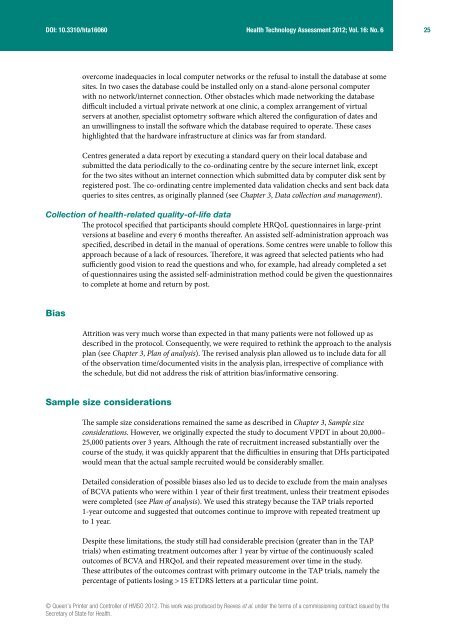Verteporfin photodynamic therapy for neovascular age-related ...
Verteporfin photodynamic therapy for neovascular age-related ...
Verteporfin photodynamic therapy for neovascular age-related ...
You also want an ePaper? Increase the reach of your titles
YUMPU automatically turns print PDFs into web optimized ePapers that Google loves.
DOI: 10.3310/hta16060Health Technology Assessment 2012; Vol. 16: No. 625overcome inadequacies in local computer networks or the refusal to install the database at somesites. In two cases the database could be installed only on a stand-alone personal computerwith no network/internet connection. Other obstacles which made networking the databasedifficult included a virtual private network at one clinic, a complex arrangement of virtualservers at another, specialist optometry software which altered the configuration of dates andan unwillingness to install the software which the database required to operate. These caseshighlighted that the hardware infrastructure at clinics was far from standard.Centres generated a data report by executing a standard query on their local database andsubmitted the data periodically to the co-ordinating centre by the secure internet link, except<strong>for</strong> the two sites without an internet connection which submitted data by computer disk sent byregistered post. The co-ordinating centre implemented data validation checks and sent back dataqueries to sites centres, as originally planned (see Chapter 3, Data collection and man<strong>age</strong>ment).Collection of health-<strong>related</strong> quality-of-life dataThe protocol specified that participants should complete HRQoL questionnaires in large-printversions at baseline and every 6 months thereafter. An assisted self-administration approach wasspecified, described in detail in the manual of operations. Some centres were unable to follow thisapproach because of a lack of resources. There<strong>for</strong>e, it was agreed that selected patients who hadsufficiently good vision to read the questions and who, <strong>for</strong> example, had already completed a setof questionnaires using the assisted self-administration method could be given the questionnairesto complete at home and return by post.BiasAttrition was very much worse than expected in that many patients were not followed up asdescribed in the protocol. Consequently, we were required to rethink the approach to the analysisplan (see Chapter 3, Plan of analysis). The revised analysis plan allowed us to include data <strong>for</strong> allof the observation time/documented visits in the analysis plan, irrespective of compliance withthe schedule, but did not address the risk of attrition bias/in<strong>for</strong>mative censoring.Sample size considerationsThe sample size considerations remained the same as described in Chapter 3, Sample sizeconsiderations. However, we originally expected the study to document VPDT in about 20,000–25,000 patients over 3 years. Although the rate of recruitment increased substantially over thecourse of the study, it was quickly apparent that the difficulties in ensuring that DHs participatedwould mean that the actual sample recruited would be considerably smaller.Detailed consideration of possible biases also led us to decide to exclude from the main analysesof BCVA patients who were within 1 year of their first treatment, unless their treatment episodeswere completed (see Plan of analysis). We used this strategy because the TAP trials reported1-year outcome and suggested that outcomes continue to improve with repeated treatment upto 1 year.Despite these limitations, the study still had considerable precision (greater than in the TAPtrials) when estimating treatment outcomes after 1 year by virtue of the continuously scaledoutcomes of BCVA and HRQoL and their repeated measurement over time in the study.These attributes of the outcomes contrast with primary outcome in the TAP trials, namely thepercent<strong>age</strong> of patients losing > 15 ETDRS letters at a particular time point.© Queen’s Printer and Controller of HMSO 2012. This work was produced by Reeves et al. under the terms of a commissioning contract issued by theSecretary of State <strong>for</strong> Health.
















